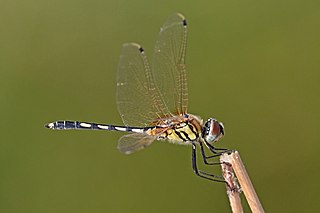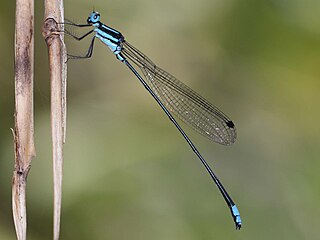
Trithemis aurora, the crimson marsh glider, is a species of dragonfly in the family Libellulidae. It is a common and widely distributed species found throughout the year across the Indian subcontinent and Southeast Asia.

Onychargia atrocyana a species damselfly in the family Platycnemididae. This species is commonly known as the marsh dancer or black marsh dart. It is found in Asia: Bangladesh, China, Hong Kong, Indonesia, India, Sri Lanka, Myanmar, Malaysia, Philippines, Peninsular Malaysia, Singapore, Thailand, Viet Nam.

Esme longistyla is damselfly in the family Platycnemididae. It is commonly known as the Nilgiri bambootail. It is endemic to Western Ghats in India.

The long-legged marsh glider or dancing dropwing is a species of dragonfly found in Asia.

Copera vittata is a species of damselfly in the family Platycnemididae. It is native to Asia, where it is widely distributed from India to Indonesia. It is known commonly as the blue bush dart. There are several subspecies and it may represent a species complex.

Lestes elatus is a species of damselfly in the family Lestidae, the spreadwings. It is known commonly as the emerald spreadwing. It is native to India, Thailand and Sri Lanka.

Cratilla lineata, the line forest-skimmer, emerald-banded skimmer or pale-faced forest-skimmer, is a species of dragonfly in the family Libellulidae. It is found in many Asian countries.

Zygonyx iris, the emerald cascader or iridescent stream glider, is a species of dragonfly in the family Libellulidae. It is widespread in many Asian countries.

Heliocypha bisignata, stream ruby, is a species of damselfly in the family Chlorocyphidae. It is endemic to South India where it breeds in hill streams in the southern part of the country.

The Coorg torrent hawk, Macromia ellisoni, is a species of dragonfly in the family Macromiidae. It is a rare and endemic dragonfly and found only in Western Ghats in South India.

Calocypha laidlawi, or myristica sapphire, is a rare species of damselfly belonging to the family Chlorocyphidae. It is found only from Karnataka and Kerala in South India.

Paracercion calamorum, the dusky lilly-squatter, is a species of damselfly in the family Coenagrionidae. It has a range that extends from southern far-eastern Russia to Japan, and to India and Indonesia. The nominate subspecies P. c. calamorum is known from central and eastern China, Korea and Japan. The subspecies P. c. dyeri occurs in southern China, Hong Kong, Taiwan, Indonesia, India, Nepal, and Thailand.

Euphaea cardinalis, Travancore torrent dart, is a species of damselfly in the family Euphaeidae.

Caconeura ramburi is a damselfly species in the family Platycnemididae. It is commonly known as the Coorg Bambootail or Indian blue bambootail. It is endemic to Western Ghats.

Disparoneura apicalis, black-tipped bambootail is a damselfly species in the family Platycnemididae. It is endemic to Western Ghats. It was described from Kodagu, Karnataka, on the upper reaches of the Kaveri River. It is also found to occur in Kuruvadweep, Wayanad, Kerala, along the banks of Kabini River.

Disparoneura quadrimaculata, black-winged bambootail is a damselfly species in the family Platycnemididae. It is a widely distributed species in India.

Elattoneura souteri is a damselfly species in the family Platycnemididae. It is endemic to Western Ghats in India.

Phylloneura westermanni, Myristica bambootail is a damselfly species in the family Platycnemididae. It is endemic to Myristica swamps of Western Ghats in India. The habitat is restricted to a few localities in Karnataka, Kerala and Tamil Nadu.

Esme mudiensis is a damselfly in the family Platycnemididae. It is commonly known as the Travancore bambootail. It is endemic to the Western Ghats in India, particularly south of Palakkad Gap.

Davidioides martini, Syrandiri clubtail, is a species of dragonfly in the family Gomphidae. It is known only from the Western Ghats of India.
























